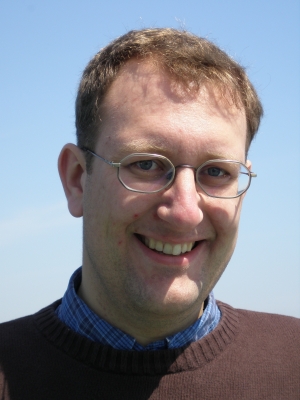
 Christoph Pfrommer
Christoph Pfrommer
- [CP1] The physics of cosmic rays: Cosmic rays consist of charged elementary particles that move incredibly fast, close to the speed of light. The talk will explain explain the astrophysical mechanisms underlying the acceleration of ordinary elementary particles to these enormous velocities (the Fermi mechanisms at powerful shock waves driven by exploding stars or alternatively powered by mass accretion onto supermassive black holes) and show, how plasma instabilities driven by the accelerated cosmic rays can amplify the magnetic fields at the shock (the so-called Bell instability). The talk should briefly give an overview of different transport mechanisms of cosmic rays from the sources to us where they are detected.
- [CP2] The physics of galactic winds: Recent cosmological simulations have demonstrated that feedback by star formation and supernovae appears to be critical in obtaining realistic disk galaxies, to slow down star formation to the small observed rates, and to move gas and metals out of galaxies into the intergalactic medium. But how is this success obtained? Suggestions include mechanical energy input by supernovae, energy and momentum deposition by cosmic rays and/or radiation processes (ionization and pressure). The talk will give an overview of the basic physical concepts and explain the pros and cons of every suggested mechanism.
- [CP3] Radio-mode feedback by active galactic nuclei: Recent cosmological simulations have demonstrated that feedback by active galactic nuclei is crucial to balance radiative cooling of the low-entropy gas at the centers of galaxy clusters. This progress still has the caveat that “feedback” was modeled empirically and involved tuning to observed global relations, substantially weakening the predictive power of hydrodynamic simulations. The talk will explain different suggestions for the physical processes responsible for heating the cooling plasma (heating by shocks, turbulence or cosmic ray streaming) and present the strength and weaknesses of each.
- [CP4] Particle transport in galaxy clusters: Clusters of galaxies are the largest bound objects in existence and an important touchstone in understanding the formation of structures in our Universe. The intra-cluster plasma in galaxy clusters is magnetized and collisionless and thus shows interesting properties that are quite different from our day-to-day experience. Electrons transport heat and protons momentum and both are bound to follow individual field lines. The talk should introduce the concepts and discuss some recent new developments on extending those by considering plasma processes (like mirror instabilities).
- [CP5] Radio halos and relics in galaxy clusters: Some of the most massive galaxy clusters shine in the radio band - so-called radio synchrotron halos and relics. This emission extends over several million light years and remains enigmatic. Apparently giant cluster collisions trigger this emission by dissipating enormous gravitational energies that are released during such a merger, channeling it (in part) to magnetic fields and relativistic electrons that emit radio synchrotron radiation. The talk will explain the phenomenology, explain the physical models (which electrons are accelerated and where do the magnetic fields come from) and explains the pros and cons of each model.
- [CP6] Heating the universe by TeV blazars: Active galactic nuclei feedback drives structure formation in the universe, imparting cosmological consequences by supermassive black holes. Typically this feedback acts locally, arising from the prodigious luminosity of quasars or mechanical power of jets. However, it has become apparent that non-local feedback may also occur on cosmological scales via a chain of events that begins with the very-high energy gamma-ray emission of blazars and ends with the heating of the low-density intergalactic medium, increasing its temperature by more than an order of magnitude. The viability of this mechanism depends critically on the nonlinear development of beam-plasma instabilities driven by the propagating very-high energy gamma rays; the observational impact requires large-scale cosmological simulations of the Lyman-alpha forest and the formation of dwarfs to infer.
- [KJ1] The physics of hierarchical structure formation: The formation of large-scale structure in the Universe is governed by gravitation and the details of cosmological parameters and initial conditions after the Big Bang. Simulations are being used to evaluate how these different parameters translate into observables throughout the observable Universe. This talk should explain how simulations do this and which observables are central in differentiating between cosmological models. Key words are power spectra of galaxy distributions, masses but also structure of local galaxies as the Milky Way.
- [KJ2] Constituents of dark matter: Dark matter is "elusive" in the sense that we so far only measure its effect but have not yet found the underlying particle. Different DM flavours have different effects. An overview shall be given of cold and warm DM, self-interacting DM, and others, and the observational tests to differentiate between them. Which are the underlying particle physics models, what is freeze-out, and what are WIMPs and which other candidate particles exist?
- [KJ3] Supermassive black holes in galaxies: The scaling relations of supermassive black holes in galaxies have been known for 15 years and are now textbook knowledge (of Intro Astro 2). But what is the genesis of these scaling relations? Did they evolve over time and if so, how can this be interpreted? How do BHs grow and which mechanisms influence the relative growth of BH mass density and that of stellar mass in the Universe? What is the current knowledge about BH seeds at early times?
- [KJ4] Accretion and jets around black holes: Supermassive black holes grow by accretion of gas transported inward from galactic scales. Under some conditions also energetic jets are formed which emit matter at relativistic velocities, which can have substantial impact on the surrounding galaxy. What are the basic principles and mechanism of accretion on different scales? How are jets launched and, collimated and accelerated?
- [KJ5] Formation of galactic bulges: Galaxies form in the centers of dark matter halos by conversion of gas into stars and by merging of smaller galaxies into larger ones. While stars form mostly in the galaxies' gaseous and kinematically "hot" disks, in the end phase of galaxy evolution, most stars are part of kinematically "cold" bulges or spheroids. This talk will present the background of how and why galaxy kinematics change over time, with emphasis on galaxy merging and "secular", long term processes. Simulations and observational data complement this topic.
- [KJ6] Dwarf galaxy alignment in the Milky Way and M31: The formation of galaxies by star formation and subsequent merging of smaller galaxies then the dwarf companions around Milky Way and M31 are a local laboratory for galaxy formation. We can observe intact dwarfs and disrupted ones seen as relic streams. If these merging processes are expected to be random, observations show that there is likely a non-homogenous spatial distribution of dwarf companions both around the MW and M31. After an introduction onto hierarchical galaxy formation present the implications for structure formation from this observation.
Galaxy formation and high-energy astrophysics
Understanding the physics of galaxy formation is arguably among the greatest problems in modern astrophysics. This Master Seminar aims to close the gap between the academic lectures on basic astrophysical processes and observational methods on the one side and cutting-edge scientific work on the other. The main aim of it is to create a vibrant atmosphere where the students can learn exciting new concepts while transporting scientific media literacy. Subject of this Master Seminar is the formation of galaxies and cluster of galaxies in general and related physical processes for their constituents: dark matter, gas, radiation, and cosmic rays. Participants will independently prepare a topic in this field, resulting in a presentation of ~35 minutes plus discussions, and the preparation of a related written report.
The report/hand-out will be complementary to the oral presentation. You are asked to prepare a problem set on the topic of your presentation that consists of a general introduction and motivation (~half a page), the problem (which can be broken up into subproblems and should consist of at least one order-of-magnitude part), the detailed and explained solution, and finally end with short concluding remarks that state what physics insight you obtained by working out the problem set and talk.
First meeting with be on Friday, April 22, 2016 where we will distribute topics and assign presentation dates. The seminar take place every Friday, 9:15am to 11am at the "Seminarraum" at Mönchshofstrasse 12-14.
If you have any questions, please drop us an email:
Knud Jahnke (06221-528398), jahnke@mpia.de
Christoph Pfrommer (06221-533271), christoph.pfrommer@h-its.org